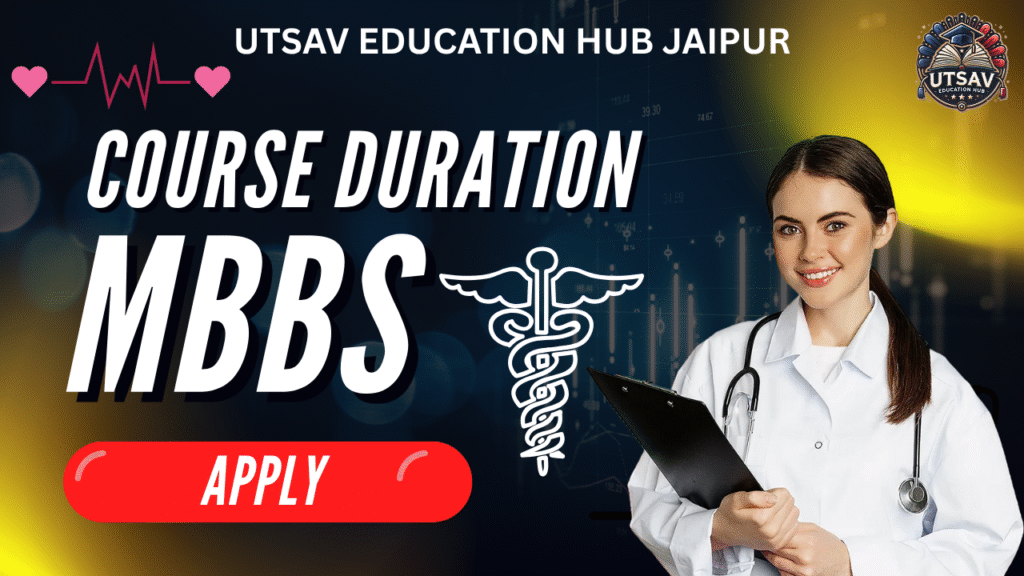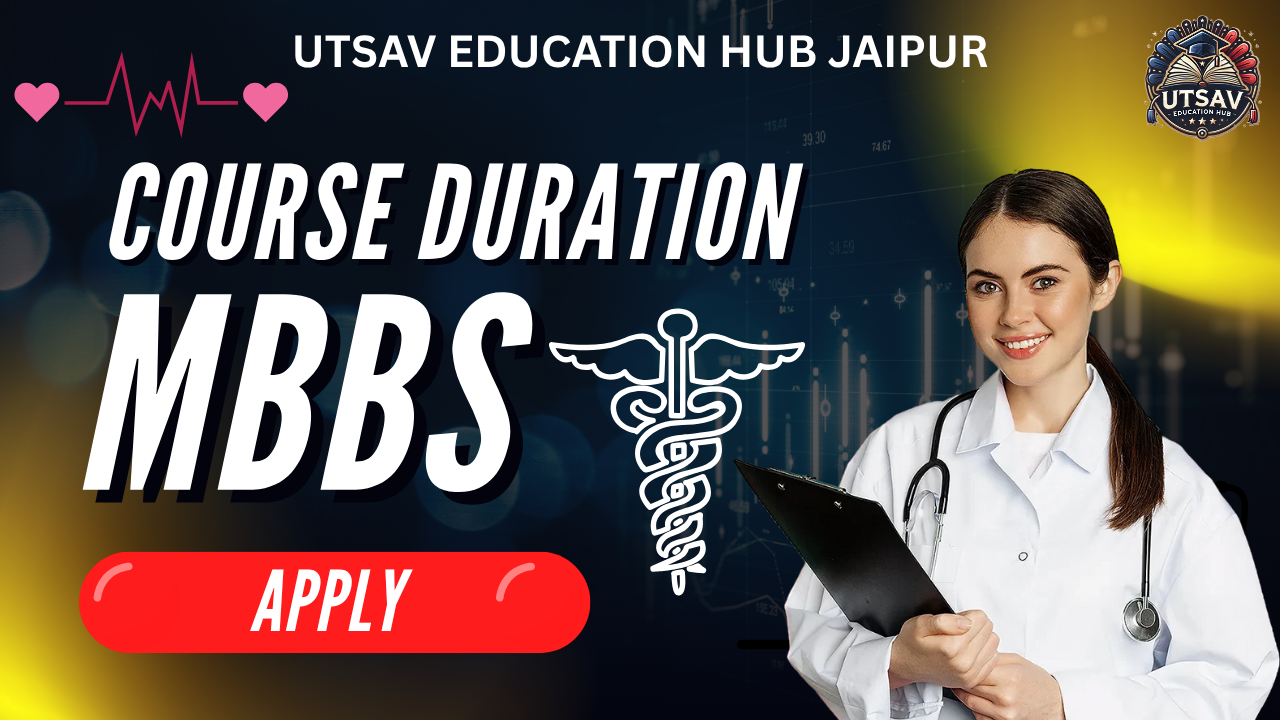The MBBS (Bachelor of Medicine, Bachelor of Surgery) is one of the most prestigious and sought-after undergraduate medical degrees in India and across the world. It is the first step for students who aspire to become doctors and serve humanity through medical science. Every year, lakhs of students appear for entrance exams like NEET-UG to secure admission to top medical colleges. But before beginning the journey, one must understand the MBBS course duration, structure, subjects, internship, and career opportunities after completing the degree.
In this article, we will discuss in detail how long the MBBS course lasts, what students study in each year, what the internship includes, and what career paths open up after MBBS. This complete guide will help students, parents, and aspirants plan their medical careers effectively.
What is MBBS?
MBBS stands for Bachelor of Medicine and Bachelor of Surgery (in Latin: Medicinae Baccalaureus, Baccalaureus Chirurgiae). It is an undergraduate medical program designed to train students in the fundamentals of human anatomy, physiology, pathology, pharmacology, and clinical practice.
The course combines both theoretical and practical learning through lectures, dissections, laboratory work, clinical rotations, and hospital internships. It enables students to diagnose diseases, understand human health, and provide medical treatment.
In India, the MBBS course duration is 5.5 years, which includes 4.5 years of academic study followed by 1 year of mandatory internship in hospitals or healthcare centers.

MBBS Course Duration in India
The total duration of the MBBS course is 5 years and 6 months. It is divided as follows:
- Academic Study (Pre-Clinical, Para-Clinical, and Clinical): 4.5 Years (9 Semesters)
- Compulsory Rotatory Internship: 1 Year
This structure is designed according to the National Medical Commission (NMC) guidelines, earlier governed by the Medical Council of India (MCI).
Year-wise MBBS Duration Breakdown
| Year | Phase | Duration | Major Focus |
|---|---|---|---|
| 1st Year | Pre-Clinical | 1 year | Anatomy, Physiology, Biochemistry |
| 2nd Year | Para-Clinical | 1.5 years | Pathology, Pharmacology, Microbiology, Forensic Medicine |
| 3rd & 4th Year | Clinical | 2 years | Medicine, Surgery, Pediatrics, Obstetrics & Gynecology, ENT, Ophthalmology |
| Internship | Rotatory | 1 year | Hands-on training in hospital departments |
Each year consists of two semesters with a mix of theoretical and practical examinations. Let’s explore each phase in detail.
MBBS Course Structure: Year-wise Syllabus and Subjects
1. First Year (Pre-Clinical Phase)
Duration: 12 months
This year focuses on the foundation of medical sciences. Students learn about the human body, its structure, and basic functioning.
Major Subjects:
- Anatomy: Study of human body structure and organs through cadaver dissection.
- Physiology: Understanding how different organs and systems function.
- Biochemistry: Learning about chemical processes and metabolic functions within the body.
Learning Outcome:
Students gain a solid understanding of the normal structure and function of the human body, preparing them for disease-oriented studies in later years.
2. Second Year (Para-Clinical Phase)
Duration: 1.5 years
In this phase, students begin to understand how diseases affect the human body. It serves as a bridge between basic science and clinical practice.
Major Subjects:
- Pathology: Study of disease mechanisms and tissue changes.
- Pharmacology: Understanding drugs, their mechanisms, and therapeutic uses.
- Microbiology: Study of microorganisms and infectious diseases.
- Forensic Medicine: Application of medical knowledge in legal investigations.
- Community Medicine (Part 1): Basics of public health and preventive medicine.
Learning Outcome:
Students learn to connect theoretical knowledge with disease diagnosis and prevention methods.
3. Third and Fourth Year (Clinical Phase)
Duration: 2 years
This is the most important stage of the MBBS program. Students begin clinical postings and interact directly with patients in hospitals under supervision.
Major Subjects:
- General Medicine: Diagnosis and treatment of common diseases.
- General Surgery: Basic surgical techniques and patient care.
- Pediatrics: Study of child health and common pediatric diseases.
- Obstetrics & Gynecology: Reproductive health, pregnancy, and childbirth.
- Ophthalmology: Eye diseases and vision care.
- Otorhinolaryngology (ENT): Ear, nose, and throat disorders.
- Community Medicine (Part 2): Field visits and preventive healthcare programs.
Learning Outcome:
Students develop clinical and diagnostic skills through hands-on experience and patient interaction.
MBBS Internship: One Year Compulsory Rotatory Internship
After completing the 4.5 years of study, every student must undergo a 1-year compulsory rotatory internship. It is a practical training program designed to provide real-life hospital experience.
Internship Duration and Department Rotation
| Department | Duration |
|---|---|
| Community Medicine | 2 months |
| Medicine (including Psychiatry) | 2 months |
| Surgery (including Anesthesia) | 2 months |
| Obstetrics & Gynecology | 2 months |
| Pediatrics | 1 month |
| Orthopedics | 1 month |
| Emergency / Casualty | 1 month |
| Elective Posting | 1 month |
During the internship, students perform medical procedures, assist doctors in surgeries, attend patient rounds, and learn to manage emergencies. They receive a stipend in government colleges during this period.
Objective:
To transform medical students into competent and confident doctors capable of handling real-world healthcare responsibilities.
MBBS Admission Process in India
To get admission into an MBBS college in India, candidates must follow a specific process governed by the National Testing Agency (NTA) and NMC.
Eligibility Criteria
- Must have completed 10+2 with Physics, Chemistry, Biology, and English.
- Minimum 50% aggregate marks in PCB (40% for reserved categories).
- Age limit: 17 years (minimum) at the time of admission.
Entrance Exam
- Admission to MBBS is done through NEET-UG (National Eligibility cum Entrance Test).
- After clearing NEET, candidates participate in state or all-India counseling to secure seats in government, private, or deemed medical universities.
Top Medical Colleges Offering MBBS in India
Some of the top medical institutions where students can pursue MBBS are:
- All India Institute of Medical Sciences (AIIMS), New Delhi
- Armed Forces Medical College (AFMC), Pune
- Christian Medical College (CMC), Vellore
- Maulana Azad Medical College (MAMC), New Delhi
- JIPMER, Puducherry
- King George’s Medical University (KGMU), Lucknow
- Grant Medical College, Mumbai
These colleges are known for their world-class infrastructure, experienced faculty, and clinical exposure.
Career Options After MBBS
After completing MBBS, students can choose from several career paths depending on their interests and goals.
1. Postgraduate Medical Education (MD/MS)
Most students choose to specialize further by appearing for NEET-PG or INICET exams. Some popular specializations include:
- MD in Medicine, Pediatrics, Radiology, Psychiatry, etc.
- MS in Surgery, Orthopedics, ENT, Ophthalmology, etc.
2. Practice as a Doctor
After completing the internship and obtaining a medical license, one can start their own clinic or join government/private hospitals as a general physician.
3. Join Government Services
Doctors can apply for UPSC, State PSC, or Armed Forces Medical Services (AFMS) to serve in government hospitals and defense services.
4. Research and Teaching
Many MBBS graduates pursue medical research or become professors in medical colleges after postgraduation.
5. Hospital Administration
With additional training in Healthcare Management (MBA in Hospital Administration), doctors can manage hospitals and healthcare institutions.
6. Opportunities Abroad
After clearing exams like USMLE (USA), PLAB (UK), or AMC (Australia), MBBS graduates can practice internationally.
Skills Required to Succeed in MBBS
- Strong academic base in Biology and Chemistry
- Good communication and empathy
- Problem-solving and analytical skills
- Patience and discipline
- Clinical observation and teamwork abilities
MBBS Course Fees in India
The fees for MBBS vary depending on the type of college:
- Government Colleges: ₹20,000 – ₹1,50,000 per year
- Private Colleges: ₹5 lakh – ₹25 lakh per year
- Deemed Universities: ₹15 lakh – ₹40 lakh per year
Scholarships are also available for meritorious and economically weaker students.
Career Scope and Salary After MBBS
The demand for qualified doctors in India and abroad is always high. After completing MBBS, doctors can earn attractive salaries depending on their specialization and experience.
Average Salary Range:
| Role | Average Salary (per annum) |
|---|---|
| Junior Resident Doctor | ₹5 – ₹8 lakhs |
| General Physician | ₹6 – ₹12 lakhs |
| Surgeon | ₹10 – ₹25 lakhs |
| Specialist Doctor (MD/MS) | ₹15 – ₹40 lakhs |
| Hospital Administrator | ₹8 – ₹20 lakhs |
With growing healthcare facilities, the career scope after MBBS continues to expand in both the public and private sectors.
Conclusion
The MBBS course is a long but rewarding journey that shapes a student into a skilled and compassionate doctor. With 5.5 years of rigorous academic and practical training, it offers a deep understanding of the human body, diseases, and their treatments.
From classroom learning to hospital internship, every phase builds knowledge, discipline, and empathy — qualities essential for a successful medical professional.
After MBBS, graduates can choose to pursue higher studies (MD/MS), start clinical practice, join government health services, or even explore global opportunities.
In short, the MBBS program not only opens the door to a respected profession but also gives you the opportunity to serve society and make a lasting impact on people’s lives.
MBBS course in India, MBBS internship, MBBS subjects, MBBS syllabus, MBBS career scope, MBBS eligibility, MBBS course details, MBBS course fees, how long is MBBS course, medical courses in India, NEET MBBS admission


Leave a Reply